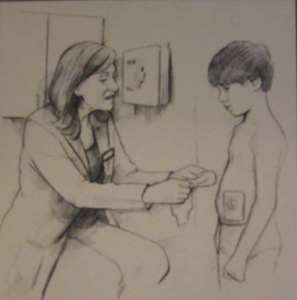
Constipation is a life-long issue for patients with SA/CRS. Severe constipation can lead to bowel impaction, a life threatening condition. Some treatment centers integrate colon, bladder and kidney care. See Center for Colorectal and Pelvic Reconstruction and meet Ashley, a child with SA/CRS who had treatment there. Also, see more centers like this here: Colorectal Centers listing.
A diet that is high in fiber, plenty of water, regular exercise, schedule for bathroom routines, and laxatives are used to manage constipation. The Mayo clinic has this link for information about use of laxatives: recommendations related to the use of laxatives.
For a list of laxatives, their use brand names and side effects click here.
Surgery Options
Surgically, there are the options of the CHAIT and the MACE
Patients with SA/CRS with neuropathic bladders also usually have neuropathic bowels, because it’s the same nerves that are often impacted, so constipation is a life long issue and has to be managed properly. Surgery is the last resort, so first diet, exercise, and stool softeners for daily stools are the first line of treatment. Enemas may be used daily of polyethylene glycol. If problems continue, a newer form of enema, described in this link: the Peristine enema, developed by the Chorloplast company can be considered ) You insert a rectal catheter so that it functions like a sphinctor to pump water up into the colon, so that you get more than a standard enema amount inside, and in that way you get more results than just a regular enema.
MACE/MALONE PROCEDURE
If surgery is necessary, then there are two options, the MACE,( also called Malone procedure) which is sort of like the mitrofonoff (see urology in the menu of this site) but the appendix is used as a valve to the colon instead of the bladder, and then you push polyethylene glycol, or saline, or water into the colon, so the push is coming from above in the colon instead of from below from the anus, like an enema. For more information, this link may be helpful: MACE information.
CHAIT PROCEDURE
The CHAIT The Chait® cecostomy procedure achieves the same goal of antegrade enema therapy but in this procedure, a tube is placed into the cecum and is left there indefinitely. An adapter attaches to the opening of the tube and the enema fluid is infused through this tube which is removed after the infusion is finished. The CHAIT involves a small appliance inserted into to large intestines and a catheter is coiled inside. On the skin surface there is a kind of trap door, and a tube is put through that and the liquid pushed through that tube into the colon, then when you are done you close the trap door, so everything moves through the intestines for stooling. The pros for that is that you don’t’ have to worry about stoma stenosis and with the appendix sometimes you develop an artificial channel so that doesn’t happen with a CHAIT, but the cons are that it is an artificial body. Now, one way that some risk for stenosis is kept at bay is by use of a stoma plug so that the channel stays so open and doesn’t constrict. For more information, this link may be helpful: Cecocostomy information.
In some cases, a colostomy is used. Here is a link from the United Ostomy Associates of Canada with good information click here
